#dame holda
Text
An example of the book's fascinating studies: as I said before, the chapter about Sleeping Beauty notices how fin-de-siècle authors, when "perverting" the tale, focused on the fairies around the baby's cradle - and Jean de Palacio notices that the names chosen for these fairies are very revealing of this "perversion".
Indeed, some authors in their twist-take on Sleeping Beauty, decided to name the group of fairies around the cradle. Anatole France, in his take on the Sleeping Beauty story in 1909, listed eight fairies: Titania, Mab, Viviane, Mélusine, Urgèle, Anna de Bretagne, Mourgue. Catulle Mendès, in 1888, had evoked in his work a total of 12 fairies - Oriane, Urgande, Urgèle, Alcine, Viviane, Holda, Mélusine, Mélandre, Arie, Mab, Titania, Habonde. Jean Lorrain did this list twice - once in 1883 including Habonde, Viviane, Tiphaine, Oriane, Mélusine, Urgèle, Morgane ; and another in 1897, simply removing Urgèle. As for Joséphin Péladan, he also did a double list: one in 1893, Mélusine, Morgane, Viviane, Mourgue, Alcine ; and another in 1895 to which he removed Mourgue to add Urgèle, Nicneven and Abonde.
These names can be taken as just random famous fairy names - but Jean de Palacio highlights that... They are not just chosen randomly, and all denote a way to discredit the fairies or to highlight their ambiguous if not negative nature. Of the recurring names four are taken from the matter of Britain, Arthurian and medieval legends: Viviane, Melusine, Anna de Bretagne (a variation of Anne of Britanny, an actual queen of France) and Mourgue/Morgane. Famous characters, right... But who is present here, around this baby's cradle to deliver gifts? Morgan le Fay, half-main villain of the Arthuriana half-healer of Avalon. Viviane, the good lady of the lake, oh yes... but also a shameless seductress who used Merlin's lust and love to steal his secrets and get rid of him. And Melusine - a national treasure, one of France's beloved legends... And a snake-woman with a strong demonic aura and devilish reputation. Viviane, Melusine and Morgan are all manifestations of the "femme fatale", of the deadly though seductive woman.
There is also a British influence at work here, since we have Titania and Mab, the two famous Shakespearian fairy queens. But Titania's reputation had already been soiled in Shakespeare's play by her mad love for a donkey - sorry, an ass ; as for Mab, in the minds of fin-de-siècle century, she is still strongly associated with the "materialistic atheism" of Percy Bysshe Shelley's poem "Queen Mab". Not perfect example of "godmothers"...
But let's return to Mourgue/Morgue briefly. Yes, she is the Franco-British Arthurian character of Morgan le Fay... But she is also part of the Italian literary tradition thanks to the Orlando Furioso, where she is Morgana, the incest-born sister of the enchantress Alcina who... Oh look! She is there too! Alcina in French is "Alcine" and in the lists you find... Alcuine. Once again, a new discredit over the fairies, as you have two wicked enchantresses dedicated to the dark art - including a lustful old hag so vain she hides her true appearance under a glamour of youth and beauty.
Of the various fairies presented in this list, only Urgèle seems to be free of any same, flaw or negative side - but that's because she is the most "recent" of them all, and not an old literary heritage or cultural figure, but rather a fresh creation. Urgèle was created by Voltaire in 1764 for a short tale/fairytale of his, "Ce qui plait aux dames", "What pleases the ladies", and immediately taken back for an "opéra-comique" adaptation by Favart in 1764, "La Fée Urgèle, ou Ce qui plaît aux dames". And while Théodore de Banville made her a good fairy victim of a wicked enchanter in his comedy "Le Baiser", "The Kiss" ; it didn't refrain Michel Carré and Paul Collin to make her the wicked fairy of Sleeping Beauty in their theatrical-opera adaptation of the fairytale in 1904...
[As a personal note, if you are interest in the other fairy names, Habonde is a variation of Abonde - la fée Abonde was a figure of popular folklore and superstitious beliefs in medieval France, an embodiment of abundance and prosperity fought off by the Church and who was tied to the rite of leaving "meals for the fairies" on special nights such as Christmas or the Epiphany. Holda is of course the same as Frau Holda/Frau Holle of Germanic mythology ; Arie is a reference to "Tante Arie", a Christmas gift-giver of eastern France, and Nicneven is a variation of Nicnevin/Nicnevan of Scottish folklore. I have to admit I do not know about the origins of Mélandre or Tiphaine.]
#sleeping beauty#fin de siecle fairytales#jean de palacio#fairy godmothers#fairies#famous fairies#fairytales with a twist
35 notes
·
View notes
Text
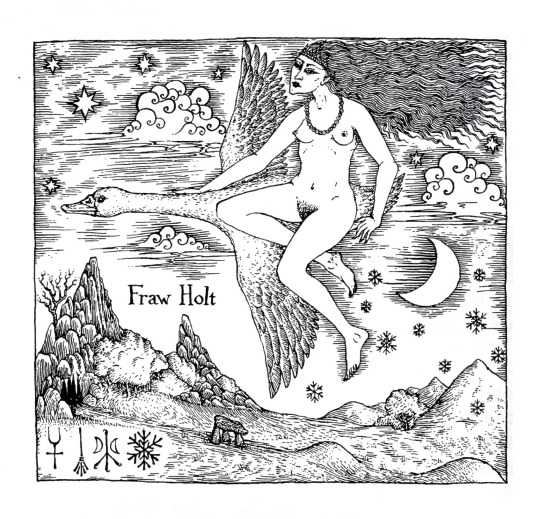
Fraw Holt or Dame Holda, the northern witch-goddess travelling upon her sacred goose through the night.
—
“Frau Holda , Venus Mountain and The Night Travellers
From the 10th Century c.e. onwards Frankish clerics and churchmen such as Regino of Prum fulminated sourly against the devilish ' belief of 'certeine wicked women that in the night times they ride abroad with Diana, the goddess of the pagans, or else with Herodias, with an innumerable multitude upon certeine beasts. This was echoed in the fourteenth century law-code of Lorraine which censured those who rode through the air with Diana. The image of the Wild Ancestral Goddess had a powerful influence upon the mediaeval imagination; the author of ‘The Romance of the Rose' wote that a third of the people have dreams of nocturnal journeys with Dame Habondia.
In Northern Europe, the sect of night travelling witches were held to fly through the sky in the retinue of the goddess Herodias or Holda, who leads the ancestral spirits of the Furious Horde in the winter months around Samhain and Yule. Like the Cymric goddess Cerridwen, Frau Holda is the archaic underworld Earth Mother, mistress of death, initiation and rebirth, who rules over the chthonic realm of Hel or Annwvyn. In Scandinavia she is known as Hela, the daughter of Loki, of whom it is related that half of her is fair and half black with decay. This signifies her bright and dark aspects as Freyja/Holda mistress of life and death. The Veiled Goddess encompasses the cosmic dualities of day and night, growth and dissolution, radiance and shadow. Her association with the Wild Hunt is strong in Germany where the ride of the death powers is sometimes called the Heljagd and in Normandy, Mesnee a Hellequin. The Indo-European original of this Witch Goddess is *KOLYO, 'the Coverer' the funereal Otherworld Queen of the Indo-European peoples from which figures as diverse as the Celtic Cailleach and Greek nymph Kalypso are descended.
The life/death aspects of Dame Hela were referred to by the German wizard, herbalist and crystal scryer Diel Breull of Calbach who confessed in 1630 that he had travelled to the pagan holy mountain, the Venusberg, 'four times a year, during the fast.' He had no idea how he got to the mountain. He then confessed he was a night traveller and 'the Frau Holle (to whom he travels) is a fine woman from the front but from the back she is like a hollow tree with rough bark. It was in Venus mountain that he came to know a number of herbs.'
This description corresponds with the female forest spirit called the Skogfru in Old Norse and the woodwife, birch maiden and wild damsel elsewhere who are beautiful women from the front but hollow behind like a rotten log. The woodwives are associated with the Wild Hunt, sometimes being pursued by Woden . (‘Woodwife’ and ‘woodwose’ both stem from the Saxon root-word ‘Wod’ - ‘wild, furious, enthused’). Like many native European initiation sites, the Hurselberg was regarded as the gateway to the underworld, the domain of Frau Venus, the classicized Freyja/Holda. From the Hurseloch cave on the mountain eldritch voices and wailing could sometimes be heard, for it led down into the magical realm of the goddess.
The mediaeval tale of Tannhauser is based upon this initiatory lore for he was a knight minnesinger (troubadour) who while riding past the cavern of the Hurselberg at twilight encountered the beautiful and entrancing Frau Venus, who took him below into the Otherworld regions to be her consort for seven years. In Scottish tradition a related pattern is exemplified by Thomas the Rymer, the thirteen century seer who met the Queen of Elfame beneath the Eildon Thorn and went with her into the world of Faery for seven years.
She gave Thomas a golden apple to eat which conferred the prophetic gift upon him. This is reminiscent of Woden's descent into the heart of Suttungr's mountain where he sleeps with the giantess Gunnlodd to attain the mead of poetic inspiration.
Such goddess forms are comparable to the shamanic Clan Mother of the nether-world in Siberian mythology. And we may note that the worship of the Northern Earth Mother Jord/Hlodyn was carried out at hills and mounds, symbols of the womb of the earth. The Furious Horde at Samhain is esoterically linked with the rune Haegl whose primal form ‘*’ represents the snowflake. This makes sense as Holda is traditionally held to shake down the snow onto the countryside; in the Channel Isles snow showers occur when Herodias shakes her petticoats. Her holy bird, the goose, is also connected with the Wild Hunt, and snow crystals are said to drift from its feathers as it flies overhead. The nocturnal cries of migrating geese are interpreted as the yelping of ghostly Gabriel hounds in Celtic lore and are symbolised by the Bird-Ogham Ngeigh at Samhain. The mystical Ninth Mother-Rune symbolises the nine nights the post-mortem soul takes to travel the Hel-Way, the prototypical Spirit-Road which runs northwards into the Underworld of Helheim.
Frau Holda is the heathen original of Mother Goose, who is remembered at winter tide, and the goose is the magical steed upon which Arctic shamans travel in visionary flight to the Otherworld. The witch Agnes Gerhardt confessed in 1596 that she and her fellow initiates used a vision-salve in order to fly to the dance like snow geese', and went on to describe how she prepared this hallucinogenie ointment by frying tansy, hellebore and wild ginger in butter mixed with egg. Such flying salves' (or Unguentum Sabbati) feature prominently in the worteunning of the night travelling witches.
In fact Styrian witches were still using them in the 19th Century. Hartliepp, court physician of Bavaria, gives a formula used by 15th century Northern witches which involves procuring seven herbs on the appropriate days of the pagan week - heliotrope on Sunna's day, fern on moon day, verbena on Tiw's day, spurge on Woden's day, houseleek on Thor's day, maidenhair on Freyja's day and nightshade on Saeter/Hela's day. This magical operation would ensure that the salve would be empowered with the energies of the principal heathen deities.
In 1582 the Archbishop of Salzburg's counsellor, the erudite mathematician and astrologer Dr. Martin Pegger, was arrested under the charge that his wife had flown with the night travellers to the goddess Herodias in the Unterberg. Within the mountain she had seen Herodias with her mountain-ladies and mountain-dwarves and the goddess is said to have come to Frau Pegger's house by Salzberg fish market on a later occasion. The mention of the goddess' mountain-dwarves is significant for they are sometimes known as the Huldravolk; the folk of the Elder, Frau Holda's holy tree.
The association of cats and hares with witches and night travellers may indicate that they inherited many of the magical techniques from the cult of Seidr, the shamanism of 'inner fire' sacred to the goddess Freyja which included trance journeys and communication with the elves and other entities. According to Saxon lore, Freyja sometimes appears amidst a company of hares and she is known to roam the meadows of Aargau with a silver-grey hare by her side in the night hours. The hare is famed as a totem form in which shapeshifting witches travel.

Freyja, the Teutonic goddess of love, sexuality and mantic sorcery riding a Siberian tiger.
It is know that a strong subterranean current of Freyja worship survived in mediaeval Germany. Closely related initiatory Mysteries existing in the British Isles usually centred on the Faerie goddess, the Queen of Elphame.
An interesting late case is the astrologer and Hermeticist John Heydon in the 17th century, who having imprudently predicted Cromwell's death was forced to flee from London to Somerset. There he claimed to have encountered a green- robed lady at a faery hill. She took him within the mount into a glass castle where he learnt much wisdom and mantic lore. This experience obviously took place in an altered state of shamanic perception.
Frau Holda is the feminine counterpart of the Master of the Wild Hunt, and she is essential to a balanced appreciation of this area of pagan spirituality. The night- travelling witches of the Northern Lands, far from being demonically deluded as ignorant and vindietive churchmen said, were in reality the preservers of a hoary Wisdom Tradition and magical world view which is now accessible to us again at the dawning of a new heathen aeon.”
—
Call of the Horned Piper
by Nigel Aldcroft Jackson
#call of the horned piper#Nigel aldcroft Jackson#magic#witchcraft#traditional withcraft#grimoire#fraw holt#dame holda
271 notes
·
View notes
Quote
Has Dame Venus been put in the place of a subterranean elf-queen, or of a goddess, such as Dame Holda or Frikka? […] There is another point of connexion with Holda: the expression ‘die guten holden’, 'guedeholden’, or holdichen, holdeken, holderchen seem perfectly synonymous with 'the good elves;’ holdo is literally a kind, favourably disposed being, and in Iceland liuflingar (darlings) and huldufolk, huldumenn are used for alfar.
Teutonic Mythology by Jacob Grimm
10 notes
·
View notes
Text
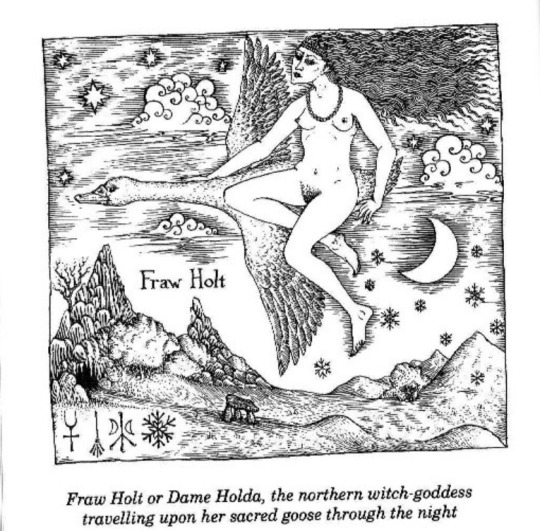
“Fraw Holt or Dame Holda, the northern witch-goddess travelling upon her sacred goose through the night”
Nigel Jackson, Call of the Horned Piper
#witchmother#hodla#call of the horned piper#traditional witchcraft#this is one of my fav illustrations from this book...
180 notes
·
View notes
Quote
A common depiction of the pale-faced Witch Queen is as a lonely old spinster sitting at a spinning wheel; "the weaver or spinner who controlled the fate and destiny of the Gods and the human race. This is of little surprise considering that the Witch Goddess is known by some as the 'Three Mothers', being in some ways a composite of the three Wyrd Sisters or Norns of Anglo-Saxon mythology, who spin, measure and cut the threads of fate. Here we return to the subject of cloaks and robes, for weaving, besides being symbolic of the manner in which linear threads of order are spun from the tangles of chaos, is a practical art that enables the witch to bring things into being, to fashion the very trappings that enclothe the magical force. This brings up the whole arena of cord magic, knot magic, knitting magic, the cat's cradle, weaving spells and so forth, but of particular relevance to this article is the art of weaving magical garments, that is to say garments as woven fate. These arts were considered under the auspices of Holda (identified by some with Nicneven, Dame Habonde, Herodias, Diana and the night goddess Lilith), who rides out through winter's night sky with her hordes of witches in tow, these being the spirits of her followers who have left their bodies to travel to the sabbat held within Holda's sacred mountain peak.
Clad in the black robe, or daubed in the black unguent as a consecration of wisdom, we are as one with the hidden and secret realm of Night, and when so enveloped we become the fertile void wherein we may receive the inspiration of the Muse or Genius, for "in the darkness of the Chasm, Night still is and is still creating, bringing forth". It is to enter the silence from within which the Word is spoken, the night-time realm of all potential, and when we realise the witch as a mediator between the worlds we realise why the witch seeks to enflesh the Dream and thereby make it manifest; such is to deliver the vision of night's phantasies into the waking world of the existent. Our world is but the manifested dream within the embrace of the Night sky, the realm of Chaos, and it is in the dark dreamtime that Chaos seeps into our River-bound world, her influence being as stars falling upon the earth from midnight's celestial vaults.
Martin Duffy - The Devil’s Raiments: Habiliments of the Witch’s Craft
91 notes
·
View notes
Text
The Witch That Whirls in the Air: The Folkloric Roots of Walpurgisnacht in “Puella Magi Madoka Magica”
“On this night, I became a Magical Girl.”--Homura Akemi, Puella Magi Madoka Magica Drama CD: “Memories of You”

(The Witch Walpurgisnacht descends on Mitakihara.)
Walpurgisnacht casts a shadow—both literally and figuratively—over Puella Magi Madoka Magica from the very beginning, first appearing in Madoka Kaname’s dream as a looming figure floating ominously in the sky, while Homura Akemi tries in vain to defeat it (the scene accompanied by the appropriately ominous song “Magia”). It isn’t mentioned again until the sixth episode, when Homura tells Kyoko Sakura that Walpurgisnacht will appear in Mitakihara in a couple of weeks, and again in Episode 10, when its importance to Homura’s story and the overall plot are revealed. In the eleventh episode, Walpurgisnacht finally makes its appearance in the city, creating a supercell storm and forcing the civilians into a shelter, leaving the city abandoned while Homura faces off against it on her own. It appears in the middle of the storm, an upside-down giant of a woman dressed in medieval clothing, with gears where her feet should be, heralded by a surreal, circus procession, and accompanied by shadowy, ghost-like Familiars. While Walpurgisnacht may at first glance appear to just be a generic monster with a distinctive name, it has many roots in folklore, not just in its name, but also in its appearance and methods.
(Spoilers incoming.)

(1668 woodcut of the Witches’ Sabbath, by Johannes Praetorius.)
Walpurgisnacht’s name is a reference to the German name for “Walpurgis Night,” named after Saint Walpurga; it is also known as “Hexennacht,” or Witches’ Night. It was in 1668 that the Brocken—the highest peak in the Harz mountain range in Germany—was designated as the meeting place for Walpurgisnacht, as recorded by Johannes Praetorius’s The Blocksberg Performance (Davies). It was this idea that was further expanded on by Goethe in Faust; a footnote for George Madison Priest’s translation of Goethe’s tragic play specifically refers to Walpurgisnacht as a time that witches hold “carnival” on the Brocken, the highest peak in Germany’s Harz Mountains, a fact that is visually referenced when Walpurgisnacht arrives in Mitakihara with a parade of colorful animals signaling its arrival (Goethe 95). While traditionally set on the evening between April 30th and May 1st, no exact day is given in Madoka for when Walpurgisnacht appears; however, it is not a stretch to assume that it is also meant to be on April 30th.
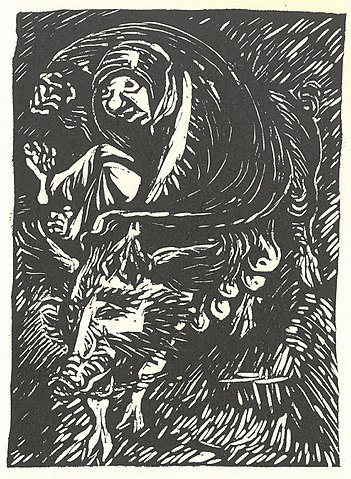
(Dame Baubo as illustrated by Ernst Barlach, c. 1923.)
While Walpurgisnacht being a name for a specific witch associated with the day is new, the idea of a central, witch-like figure is not. One example appears in Goethe’s Faust, when Faust and Mephistopheles travel to the Brocken on May Eve, following a Will-O’-The-Wisp to the sight where the witches gather. There they see a group of witches, making their way to the celebration. Among them is a figure riding on a sow—this figure is recognized as “old Baubo,” to which the witches’ chorus responds to with “In front, Dame Baubo! Lead the crew! /A sturdy sow with mother stride, /All witches follow in a tide” (Goethe 96). This figure, Baubo, actually originates from Greek Mythology, as she was a demigoddess most known for making Demeter—who, at the time, was grief-stricken over the disappearance of Persephone—laugh by exposing her genitalia (Theoi). Just like how Baubo is associated with laughter, the Walpurgisnacht of Madoka Magica is portrayed as constantly laughing as she floats in the air; additionally, one can see that Baubo, a Greek figure, has been demonized into being associated with witches and the Christian Devil. This phenomenon of such a figure being turned into a demonic creature is not unique to Faust.
In their article “Becoming the Labyrinth: Negotiating Magical Space and Identity in Puella Magi Madoka Magica,” Sara Cleto and Erin Kathleen Bahl point out that Walpurgisnacht has many visual similarities to European nobility, shown in her “elaborate, blue gown with exaggerated bell sleeves and a cascading, tiered skirt,” while her head has a headdress that “tapers to two sharp points, suggesting horns or a crown.” “She resembles nothing so much as an evil queen,” Cleto and Bahl write, “a figure popularized most by Snow White tales” (9). Indeed, with the other folkloric/fairy tale imagery (both traditional and literary) referenced in the series such as “The Little Mermaid,” The Nutcracker and the Mouse King, and Goethe’s Faust, it would not be too far of a stretch to draw comparisons between Madoka and Snow White, especially since, as Cleto and Bahl point out, a central theme in Snow White is the generational conflict between a young girl and an older woman, which echoes the war between the Magical Girls and the Witches they will inevitably become when they are consumed by despair (9).
But if one looks at Walpurgisnacht’s general appearance—a queenly figure that rides out in the sky and terrorizes the land, especially children (the Magical Girls)—then one can also draw a parallel to the Biblical queen Herodias; specifically, the version of her that became a part of witch folklore. In the Book of Mark in the New Testament, Herodias was the wife of Herod who opposed John the Baptist, as the latter spoke against her marriage to Herod, because she had been Herod’s brother’s wife beforehand. She eventually gets rid of John by having her daughter dance for Herod at a party, who, impressed, offers to grant her anything; she then asks for John the Baptist’s head (New Living Translation, Mark 6:14-29) .
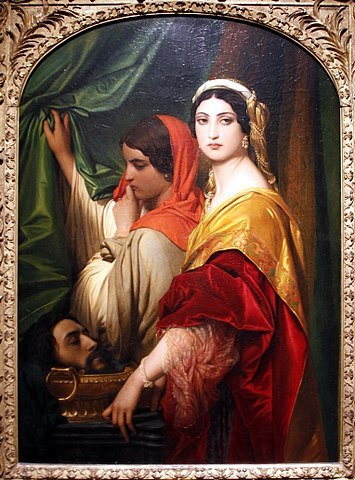
(Herodias, as painted by Paul Delaroche, c. 1843.)
That is where the story ends in the Bible, but folklore expands a bit on the aftermath. In Ysengrimus, a collection of folktales in Latin written by the poet Nivardus around the year 1148, Herodias is conflated with her daughter as the figure who danced for Herod; after receiving the head of John the Baptist, Herodias attempts to kiss it, having been infatuated with him. However, the head hisses at her, “with such force that she was blown up into the air and out through the skylight;” and since then, “she has been driven through the skies on John’s implacable anger” (Ridenour 135-136). Jacob Grimm writes in his Deutsche Mythologie that the winds in Lower Saxony were believed to be caused by Herodias constantly whirling, eternally dancing in the sky; additionally, she was believed in some places to be a child-stealing demon (Ridenour 136). Just as Herodias is associated with eternally whirling in the air, Walpurgisnacht in Madoka is described as symbolizing “the fool who constantly spins in circles” and whose nature is “helplessness” (Puella Magi Wiki). And Walpurgisnacht, as a Witch who was once a Magical Girl, certainly is helpless, being now nothing more than a pawn in the Incubators’ twisted plans.
In his book Witchcraft in the Middle Ages, Jeffrey Burton Russell refers to the Canon Episcopi, a text written in the early Tenth Century; the text itself refutes the existence of witches, in that it claims that any such stories are the result of people being deceived by the Devil, upholding the opinion that it is impossible for a human to wield magic (Russell 77). Within the Canon are references to witches who rode out in the night with “Diana, goddess of the pagans,” a reference to Diana, the Roman goddess of the hunt (Russell 76). Russell then adds that Diana is one of many goddesses demonized to be associated with Witches by Christianity; another example being the Germanic Holda, who is mentioned in the Corrector by Buchard of Worms, another important document of witchcraft (80-81). In Eisenach, Germany, Holda and her host are said to emerge from the Horselberg Mountain (“Hear-Souls Mountain”) with her horde of spirits on Christmas, Eve, New Year’s Eve, or the Winter Ember Days (Ridenour 132). This idea of a witch-like figure emerging on a certain day is echoed in Madoka with Walpurgisnacht’s arrival creating a deadline that the series’ plot hinges on.
Those familiar with Madoka may also note the idea of a figure being seen as both a goddess and a witch as paralleling Madoka’s status as being both Ultimate Madoka (a goddess) and Kriemhild Gretchen/The Witch of Despair (a witch); in fact, the idea of a goddess being demonized into a Witch by the Church is a pretty close parallel to the Incubators turning Magical Girls into Witches for their own plans. (There is some debate on whether Holda was a goddess or not, due to records describing her as such being made long after Christianization set in; nonetheless, the similarities are there (Ridenour 120).)

(Frau Holle, or Holda, traveling through the air with her spirits, by Joseph Sattler, c. 1927.)
After her initial attack on Walpurgisnacht—during which Homura throws an entire arsenal of weapon fire at it, barely putting even a scratch on the Witch—Walpurgisnacht manifests a horde of shadowy figures that begin to attack Homura. These minions are described as “countless souls drawn to [Walpurgisnacht’s] vast magical power,” and bear more than an uncanny resemblance to ghostly Magical Girls (Puella Magi Wiki). In concept, as ghastly beings flying amongst the storm, they are akin to the European legends of the Wild Hunt, a folkloric archetype that combines elements of stories regarding “hunting and diabolic hunters, lost souls, and slain warriors” (Ridenour 156). Slain warriors and lost souls—kind of like the Magical Girls of Madoka’s setting, who are shown to often die in battle at a young age; and whenever a contract is made with Kyubey, the result is the girl making said contract having her soul removed from her body, effectively rendering her undead, and therefore able to endure the physical strain of battling horrific entities. While the Wild Hunt is said in many cases to be led by Odin, there are stories where other leaders have been recorded; one such example being, again, Herodias, said to have sway over a third of the world, said third including “unbaptized children,” amongst other supernatural creatures such as elves and gnomes (Kloss 100). A similar belief is attributed to the figure Perchta, who is sometimes associated with Holda, and said to lead the spirits of the unbaptized and unborn out into the night (Ridenour 132).
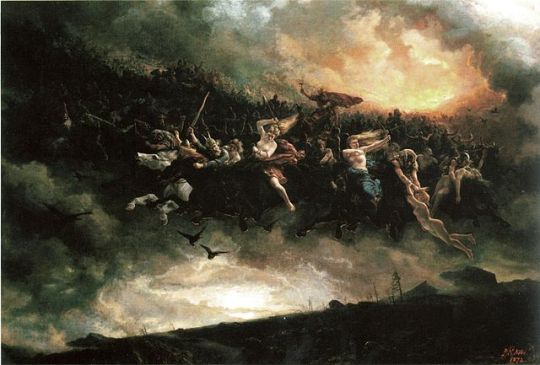

(Top: Asgardsreien, by Peter Nicolai Arbo, c. 1872. Bottom: The Clowns serving Walpurgisnacht.)
Finally, while the influences on Walpurgisnacht have thus far been entirely Biblical and European in origin, there is also Japanese folklore to look to for a possible link between the legends of the West and the country of Madoka’s origin. Japan is full of stories regarding supernatural creatures, or “yokai;” there are also stories regarding the event known as the “Hyakki Yagyo,” or “The Demon Horde’s Night Parade,” when yokai were said to swarm through the city of Kyoto. In many ways, it was less of an attack and more of a swarm or manifestation that went throughout the city, akin to the Western concept of “pandemonium,” a “raucous revelry of creepy-crawlies” (Yoda and Alt x-xi). This legend is in many ways similar to the Wild Hunt of Europe; as such, while Walpurgisnacht’s imagery in Madoka is heavily-inspired by stories of witches and slain warriors swarming during a storm, the knowledge Japanese viewers may have of the Hyakki Yagyo would just as easily make Walpurgisnacht’s attack resonate with them, much like the term “Walpurgisnacht” resonates with those in the West familiar with the word as a serious threat in a series whose main enemies are Witches.
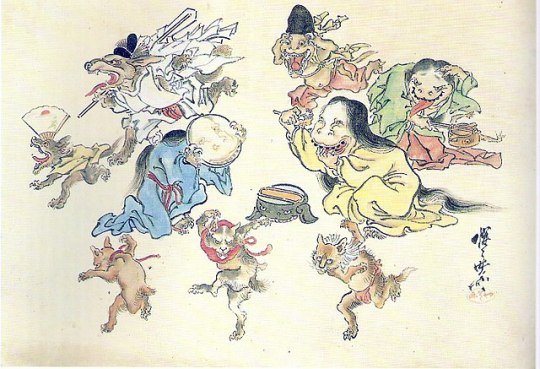
(”Hyakki Yagyo,” by Kawanabe Kyosai.)
While Walpurgisnacht makes only a few appearances in the whole of Puella Magi Madoka Magica, its influence is greatly felt throughout the series; and while ultimately just an obstacle keeping the main characters from reaching a happy ending, it also has a lot of mythological, folkloric, and literary archetypes of witches and hauntings caused by spirits, all rolled into one enigmatic figure (indeed, even after the origin of Witches are revealed, Walpurgisnacht still remains a mystery in everything from backstory to motives). Like a lot of the folkloric and literary references in the show, it is not necessary to be aware of all the history behind Walpurgisnacht to understand the narrative; that being said, if one does choose to look into it, they will find quite a lot of interesting stories.
Bibliography
“Agrarian Gods and Goddesses.” Theoi. Web. Accessed 23 April, 2019.
Cleto, Sara and Erin Kathleen Bahl. “Becoming the Labyrinth: Negotiating Magical Space and Identity in Puella Magi Madoka Magica.” Humanities, 5:20 (2016).
Davies, Owen. “Witches and Walpurgis Night.” OUPBlog. Web. Accessed 27 April, 2019.
Goethe, Johann Wolfgang von. Faust. Translated by George Madison Priest, William Benton, 1952.
Kloss, Waldemar. “Herodias the Wild Huntress in the Legend of the Middle Ages.” Modern Language Notes, 23:4 (1908), pp. 100-102.
Ridenour, Al. The Krampus and the Old, Dark Christmas: Roots and Rebirth of the Folkloric Devil. Feral House, 2016.
Russell, Jeffrey Burton. Witchcraft in the Middle Ages. Cornell University Press, 1972.
Sekien, Toriyama. Japandemonium Illustrated: The Yokai Encyclopedias of Toriyama Sekien. Translated by Hiroko Yoda and Matt Alt, Dover Publications, Inc., 2016.
Shinbo, Akiyuki and Gen Urobuchi. Puella Magi Madoka Magica. Studio Shaft, 2011.
The Bible. New Living Translation, Tyndale House Publishers, Inc., 1996.
“Walpurgisnacht.” Puella Magi Wiki. Web. Accessed 23 April, 2019.
Yoda, Hiroko and Matt Alt. “About The Books.” Japandemonium Illustrated: The Yokai Encyclopedias of Toriyama Sekien. Translated by Hiroko Yoda and Matt Alt, Dover Publications, Inc., 2016.
#puella magi madoka magica#walpurgisnacht#walpurgis night#madoka kaname#homura akemi#kyubey#witch#herodias#frau holle#frau holda#the wild hunt#hyakki yagyo#yokai#folklore#television#animation#anime#faust#goethe#random thoughts#analysis#long post#text
273 notes
·
View notes
Text
Walpurgis Night
30 DE ABRIL - WALPURGISNACHT / BELTANE EVE (Hemisferio Norte)
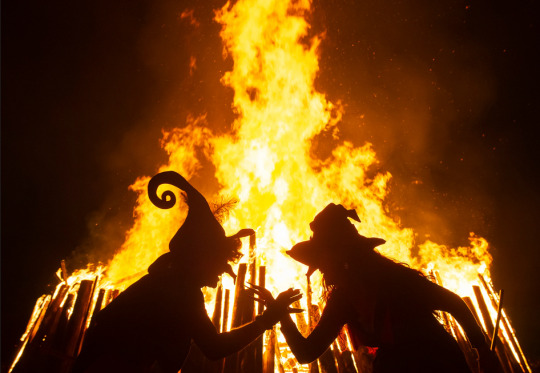
Na tradição celta, a última noite de abril era considerada a mais escura do ano. A transição entre inverno e verão é um ponto liminar, um tempo entre tempos e, portanto, cercado por perigo e forças sobrenaturais. Acreditava-se que espíritos malignos e bruxas voavam para assustar as pessoas, gerando o mal por toda a terra. As fadas malvadas das travessuras e os espíritos do inverno fazem uma última incursão, pois, ao amanhecer de amanhã, as boas fadas surgirão e reivindicarão completamente a terra para o verão. Na Grã-Bretanha e na Irlanda, as pessoas batiam em chaleiras, batiam portas, chicotes quebrados, tocavam sinos de igrejas e faziam todo o barulho possível para espantar a corrupção que imaginavam estar se movendo no ar. Acendiam fogueiras e tochas, e penduravam prímulas ou sorva e linhas vermelhas cruzavam os celeiros e as árvores para proteger os animais. Tais vigílias foram mantidas durante toda a noite até a aurora de Maio, quando as forças de desgraça seriam finalmente derrotadas e o verão seria entregue em segurança.
Na Alemanha, 30 de abril é Walpurgisnacht, em homenagem a St Walpurga, uma inglesa do século VIII que se tornou a abadessa de um mosteiro alemão. Ela era conhecida por lutar contra pragas, doenças e bruxaria, por isso não é de surpreender que as pessoas pedissem sua intercessão para protegê-las dos espíritos malignos e da peste, uma das noites mais perigosas do ano.
E dito que por nove noites antes do primeiro de maio, Walpurga está em fuga, perseguida pela Caçada Selvagem, indo de vila em vila. As pessoas deixavam suas janelas abertas para que ela pudesse se abrigar atrás dos suportes em forma de cruz dos seus inimigos. Em agradecimento, ela colocava uma pequena moeda de ouro no peitoril da janela e foge ainda mais longe. Um fazendeiro a descreveu como uma dama branca, com cabelos esvoaçantes, uma coroa na cabeça e sapatos de ouro flamejante, enquanto nas mãos ela carregava um fuso e um espelho de três pontas que mostravam todo o futuro. Uma tropa de cavaleiros brancos perseguiu e tentou capturá-la. Walburga pediu a outro fazendeiro que a escondesse em um maço de grãos. Assim que ela se escondeu, os cavaleiros passaram correndo por cima. Na manhã seguinte, o fazendeiro encontrou grãos de ouro em vez de centeio. As histórias parecem ser uma analogia do verão que foge do inverno nessa época do ano. As procissões de Walburga promulgadas em torno das vilas e campos da Alemanha e da França devem proteger as terras contra ventos fortes e intempéries no próximo mês.
É seguro presumir que as práticas folclóricas em torno da véspera de São Walpurga eram anteriores à santa e foram subsequentemente associadas a ela, o que significa que a verdadeira Walpurga assumiu os atributos de uma deusa anterior da fertilidade, ou possivelmente as características combinadas de várias. Igrejas na Alemanha e em Antuérpia, e um manuscrito do século XI de Colônia, mostram St. Walpurga com espigas de grãos, como deusas-mãe primitivas. Ela é representada com um cachorro, como a deusa da fertilidade celto-germânica Nehalennia, bem como Frau Gode e Frau Frick (Frigga). Pode haver alguma conexão com o Windhound, um cão misterioso ligado à fertilidade deixado para trás pela caça selvagem, que deve ser alimentada para garantir boas colheitas. Outras ilustrações mostram-na com uma equipe. A palavra gótica walus parece ser um epíteto de alguém (geralmente mulher) que exerce uma equipe mágica de ofícios, um sibilador ou adivinho, como o histórico Waluburg de 500 anos antes, uma mulher da tribo germânica Semnonii que serviu como conselheira mística a um governador romano do Egito no segundo século EC. É possível que houvesse originalmente uma deusa chamada Walburga, Waldborg ou Walburg, como sugerem vários sites e livros pagãos, embora exista uma falta distinta de evidência direta para isso.
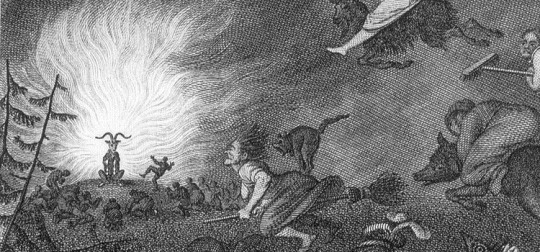
Walpurgisnacht também é conhecida como Hexennacht ou 'Noite das Bruxas' na Alemanha, quando as bruxas estão no exterior, muitas voando para se divertir no Brocken, o pico mais alto das montanhas Harz, um lugar misterioso com duas formações rochosas chamadas O Púlpito do Diabo e O Altar da Bruxa, bem como o espectro de Brocken - halos estranhos de luz vistos ao redor da montanha. De acordo com Grimm, algumas montanhas já foram a residência de Dame Holda, a antiga casa do inverno, e suas anfitriãs, as 'mulheres da noite' que cavalgavam no ar em certas noites e faziam gentilezas aos homens. Foi a própria Holda quem liderou os foliões nas montanhas para dançar expulsando a neve.
Amanhã, o verão chegará, mas hoje à noite as forças do inverno tentarão fazer seu ataque final e precisam ser combatidas. Os festivais do Dia de Maio tradicionalmente incluíam uma batalha feroz entre as forças do inverno e do verão.
© Anna Franklin, from the forthcoming Hearth Witch’s Ritual Year, Llewellyn, 2021
0 notes
Text
“Elder is considered unlucky because its wood was used for the cross on which Jesus was crucified and was also the tree Judas hanged himself on. However in pagan times it was sacred to the Elder Mother, the Germanic witch-goddess Dame Holda. It was considered highly dangerous to cut down an elder or take one of its branches without first asking her permission. Even then it was considered bad luck because cutting the tree raised the Devil, unless of course that was your desire! Elder was known as a 'wicked wooď and in Staffordshire burning it on the hearth was supposed to invite the Owd Lad to come down the chimney into the house like a demonic Santa Claus.”
Chapter One — ‘Tools of the Arte’
—
Liber Nox:
A Traditional Witch’s Gramarye
by Michael Howard
#such a small piece of the picture#but useful still#liber Nox#Michael Howard#magic#witchcraft#traditional withcraft#grimoire#elder mother#Elder
63 notes
·
View notes
Quote
Writing in 1668 the early antiquarian Matthias Praetorius described the lore of the Wilde Heer in Thuringia during that period; the unseen army of dead souls traveled over fields, towns and villages during the ‘Holy Christmas’, led by the Old One in his guise as Eckhard, ‘the Doorkeeper or Guard of Venus Mountain’, the Sabbatic Peak of the Witches or Hurselberg, from whose caverns the Hunt rode forth and to which it returned, entering into the hidden world of Dame Venus or Herodias. Thus the Wild Huntsman is also the initiatory Doorkeeper and Threshold-Guardian of the original Otherworld Mound, in his most ancient guise.
In Germany as a whole the Lord of the Wutanes Heer (Furious Host) was the magician-sovereign an ecstatic death-god Wodan, and by his side rode the Wild Huntress named variously as Frau Wode, Frau Frie, Frau Perchta, or Holda. Old German chronologies such as that of Baden-Wurttemberg for 1550 record the awesome procession of the Furious Host traveling invisibly over the town by night, accompanied by roaring, shouting voices and ringing vibrations. For the most part the Wilde Jagd is invisible to the physical eyes and is usually heard as it passes overhead- those who see it are ‘taken’ and are swept away in the train of the dead. To behold the Hunt directly is to ‘die’ to ordinary awaresness in the ecstasy of the seer, to be rapt into the state of Otherness which the Horned Master and Wild Huntress personify and open up to us.
Nigel Jackson - Masks of Misrule: The Horned God & His Cult in Europe
12 notes
·
View notes
Quote
Yew frequently grows in churchyards as a symbol of death, resurrection and eternity and in medieval times it provided the wood for longbows. Elder is considered unlucky because its wood was used for the cross on which Jesus was crucified and was also the tree Judas hanged himself on. However in pagan times it was sacred to the Elder Mother, the Germanic witch-goddess Dame Holda. It was considered highly dangerous to cut down an elder or take one of its branches without first asking for permission. Even then it was considered bad luck because cutting the tree raised the Devil, unless of course that was your desire. Elder was known as a 'wicked wood' and in Staffordshire burning it on the hearth was supposed to invite the Owl Lad to come down the chimney in the house like a demonic Santa Claus.
Rowan, also known as mountain ash, quicken, quickbeam and witchwood, was widely regarded as an antidote to or a protection from malefic witchcraft, the malicious tricks of the faery folk and the crippling effect of the Evil Eye. An old Scottish saying was: "Rowan tree and red thread keeps the witches from their speed." It is sacred to the pagan thunder gods, and crosses of rowan placed above the doors of farm buildings warded off the faeries and stopped witches 'hag riding' horses at night to their Sabbats. When they were returned at cockcrow the horses would be covered with sweat and their mane and tails would be tangled in elf knots.
Michael Howard - Liber Nox: A Traditional Witch’s Gramarye
15 notes
·
View notes
Quote
Other popular forms of the witch goddess found in European folklore include Habondia, Herodias (the name of the wife of the biblical King Herod Antipas), Sybille, Benzonia, Bona Domina (the 'Good Lady), Nicnevin, Aradia and Mari, a Basque earth and sky goddess still worshipped by the modern Feri tradition in the United States. As the Roman Catholic Church's Holy Office of the Inquisition slowly convinced people that the Craft was a satanic cult, the old pagan goddesses dwindled in stature until they were eventually reduced to the minor status of the Queen of Elfhame' (Scottish dialect from the Old Norse for 'elf home') or queen of the faeries.
In Germany the witch goddess was popularly known as Dame Venus and she ruled the 'hollow hill' of the Venusberg. In 1630 a German sorcerer confessed that he had traveled to this mountain and had been taught the secrets of herbal lore by the goddess Venus, who he also called by the Germanic name of Holda. The cult of Dame Venus was widespread in southern Europe in medieval times and influenced both the romantic Grail legends and the troubadour tradition of 'courtly love' that was often associated with Christian heretics like the Cathars and the Albigensi.
Robert Cochrane said that the real name of the witch goddess was Fate and added that 'in the overcoming of Fate is the true Grail, for from this comes inspiration and death is defeated.' The Goddess is described as being 'as old as time and her face is as white and as cold as newly fallen snow. Her brow is as smooth and white as alabaster. Her hair is as dark as ebony, parted in the middle and hanging down to just below her shoulders. Beneath [her] thick black curving eyebrows are a pair of ice-cold, vivid blue eyes. The nose is long, thin and slightly hooked, while the mouth is large and generous with blood red lips,
Michael Howard - Children of Cain
12 notes
·
View notes
Quote
Christian monotheism places a monopoly on spiritual agency. The wolf is now a pagan pariah. Ecstasy is not an applicable spiritual technology. The ritual hunt is reserved for the king. The Mistress of Beasts is replaced by the Devil as wild nature and the force of sex: horned Venus, garbed as Saturn. The commons are enclosed. The wolf is now enemy. The full moon celebration is painted as an orgiastic child killing cult. The night ride whether the goddess is Diana, Herodias or Holda is now a flight on animals to the Sabbat. Hunt and feast have become aggregated into one awful carnival whose meaning is effaced. The witch and sorcerer are anti-social terrorists plotting to destroy Christendom.
Should we stop here and chase our tails? We have not yet run our quarry to ground. We must go on. The wolf is the shadow of man. We have hunted the same prey. But we have fallen out with these brothers and sisters, to our detriment and their extinction. Let us decide to play the game again. Let us turn over the cards of Dame Fortune. XVIII La Lune reveals even dogs are transformed on certain nights into their ancestors, and that it is blood which provides the key. Through this slim fence slip once more the gaunt wolves into the city, our throats erupting into song.
Peter Grey - Apocalyptic Witchcraft
5 notes
·
View notes